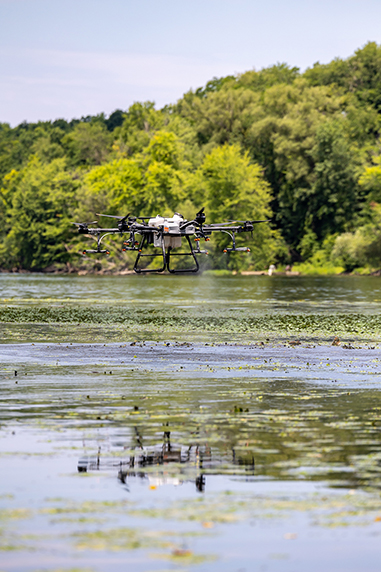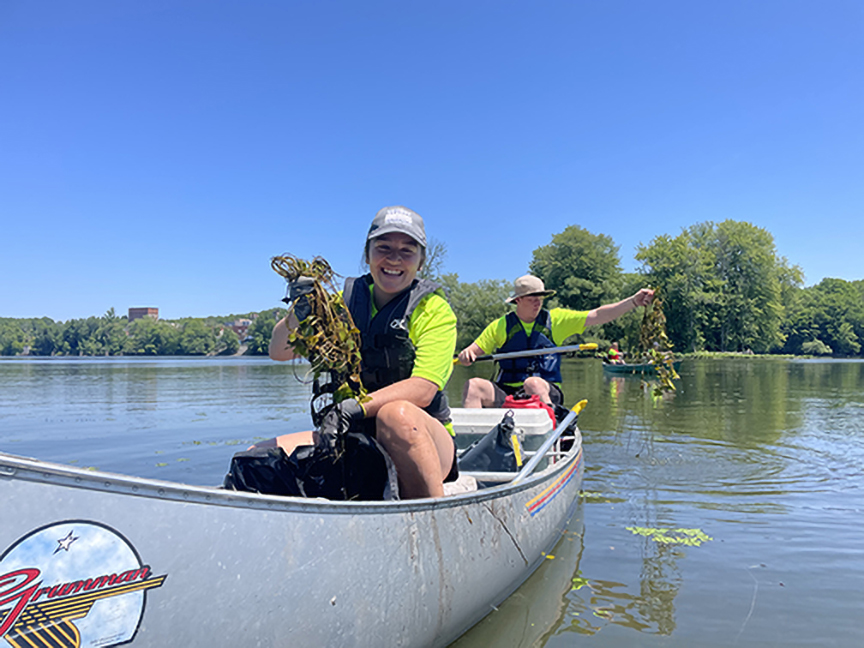Oswego County Soil and Water District Adds New Tool to Help Control Invasive Plants
Oswego County has a new dog in the fight as it works to control the water chestnut population in the Oswego River. An integrated system of hand-pulling and herbicide application now includes the use of a drone.
The Oswego County Soil and Water Conservation District (OCSWD) is working with Chase Enterprises, a high-quality infrastructure maintenance service, to tackle the invasive plant species.
“The use of the drone is new this year,” said Joe Chairvolotti, director of the Oswego County Soil and Water Conservation District. “The contractor is continuing to use an airboat to apply herbicide in some places, but they’re trying out this drone in other locations where it may be more effective.
“Allen Chase, the owner of Chase Enterprises, demonstrated the use of the drone at Big Island in Fulton and we were impressed with the outcome,” he added. “The crew covered about 40 to 50 acres over two days and, the drone didn’t displace water chestnuts as much as the airboat during the application process. It’s new technology, so we’re continuing to evaluate; but so far, we’re very pleased with the results.”
The team at Chase Enterprises had to navigate a rigorous permit process and training regimen in order to use a drone for this herbicide application. The company received approvals from the NYS Department of Environmental Conservation (NYSDEC) and the Federal Aviation Administration (FAA) to employ the drone.
Drone technology also helped map out the areas to be treated. “In preparation for using the application drone to apply the herbicide, we started with a survey drone to map out the patches previously selected by the OCSWD’s team,” said Chase. “We then used agricultural mapping software to create an optimized flight plan for the application drone that would ensure full coverage and efficiency.”
He added, “The actual application is autonomous with the drone flying itself under our supervision. The drone has onboard radar and imaging to avoid any obstacles not identified in the flight plan. The process worked very well; we believe we achieved a better result with more application efficiency than in conventional methods.”
Mapping water chestnut populations in the entire river is an extensive process that the OCSWD begins a year in advance.
The first step is to determine the areas where treatment, whether by drone or by airboat, will be most effective. The contractor, in coordination with the OCSWD, then applies for the necessary permits through the NYSDEC and the NYS Canal Corp. for the herbicide application. At that time, the OCSWD also notifies landowners along the riverbanks.
Initial herbicide treatments begin in mid-July with follow-up treatment conducted a few weeks later.
“Water chestnut seeds are viable in sediment for 10 to 12 years, so repeat applications may be needed to interrupt the seed cycle of the plant,” said Chairvolotti. “The goal of this whole integrated program is to reduce very dense water chestnut populations enough so that hand-pulling can be more effective.”
Hand-pulling water chestnuts is a group effort. The OCSWD hires a handful of college interns – preferably with an environmental background in their studies – to man the kayaks, canoes and, also new this year, a motorboat. Very carefully, they pull the water chestnut plants out of the water by hand for disposal so as not to spread their seeds. In addition, some local landowners and environment-minded volunteers go out in their own canoes and kayaks during hand-pull events to help control the plant populations.
The life cycle of the water chestnut plant creates large floating mats of vegetation that restrict sunlight and limit the growth of indigenous plants. This not only disrupts the natural food web and interferes with aquatic ecosystems, but it also significantly reduces the quality of the native habitat and impedes recreational use of waterways.
“We’ve made a lot of progress,” Chairvolotti said. “Some places are showing signs of reduction faster than others. We might not need to re-treat those areas, but we’re keeping an eye on them to be sure.
“Overall, the program has been very successful in gaining a measure of control over the water chestnuts,” he concluded. “For example, 10 or 12 years ago, we had more than 300 acres of very dense plant populations in the Oswego River and Ox Creek, and now we are down to a little more than 100 acres. Due to the extensive life cycle of water chestnuts and the rapid ease of seed transfer, we may never fully eradicate the plant, but if we can get it under control and keep it from spreading, that’s a ‘win’ for us.”
For more information about the Oswego County Soil and Water District, including updates on the water chestnut hand-pulling program, go to www.oswegosoilandwater.com or find them on Facebook at https://www.facebook.com/oswegoswcd.
To see the drone in action, check out these YouTube videos: https://www.youtube.com/watch?app=desktop&v=srLZHrbUqQk and https://www.youtube.com/watch?app=desktop&v=3a6cy4uQNMo.
To learn more about water chestnuts, go to https://www.dec.ny.gov/animals/109536.html.
USING DRONE TECHNOLOGY TO PROTECT THE ENVIRONMENT – The Oswego County Soil and Water District (OCSWD) has now added a drone to its integrated water chestnut control program. Allen Chase, of Chase Enterprises, was contracted to use this new tool to apply herbicide to the invasive water chestnut plants in the Oswego River. Photo courtesy of Chase Enterprises.
TRIED AND TRUE PRACTICES – Interns with the Oswego County Soil and Water District use tried and true practices to help save the Oswego River from water chestnut plants. The program includes six students who paddle out in canoes and kayaks to pull the invasive plants from the water. Pictured from left are Shawna Mulvihill and Payton Reese as they pull plants near Pathfinder Island in the Oswego River. Photo courtesy of the Oswego County Soil and Water District.




